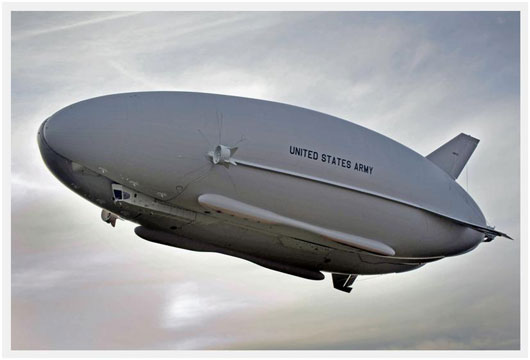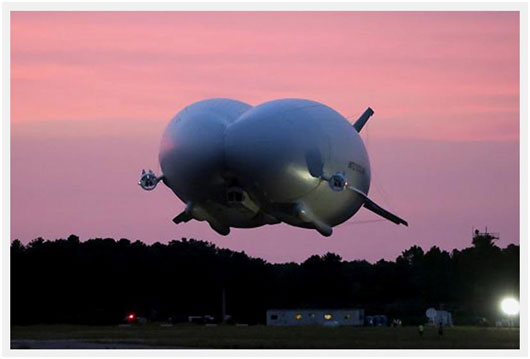The Long Endurance Multi-Intelligence Vehicle (LEMV) Is Not A Lot Of Hot Air!
 Saturday, August 11, 2012 at 10:30AM
Saturday, August 11, 2012 at 10:30AM  (click pic for hi-res) LEMV on its first flight August 7, 2012 (photo: Northrop Grumman)
(click pic for hi-res) LEMV on its first flight August 7, 2012 (photo: Northrop Grumman)
(with CoolPix and video)
Even with some nagging development delays, Northrop Grumman's Long Endurance Multi-Intelligence Vehicle (LEMV) still went thru the design/prototype/first flight process in the pretty short time frame of just over 24 months. Working with several partner organizations (most notably Hybrid Air Vehicles in England) and pulling together the latest hybrid airship technology, NoGr has taken a giant step forward in creating the first truly viable military airship concept. Some critics out there see this as just a batch of hot air, but a closer look at the capabilities and operating costs associated with the helium filled LEMV point to this being an impressive project.
The first flight, over 90 minutes in duration, was conducted on Tuesday August 7, 2012 at Lakehurst, New Jersey (sound familiar?) and it appears it was a great success. The plan at this point is for the LEMV to complete all testing and be deployed to Afghanistan by the U.S. Army in early 2013 as an airborne platform for intelligence, surveillance and reconnaissance (ISR). The ability to remain airborne for up to 21 days radically transforms the capability of an ISR platform. And, with the ability to operate with a manned crew, as a UAV, or completely autonomously, the LEMV adds significant versatility to the method in which it operates.
Long Endurance Multi-Intelligence Vehicle (LEMV) first flight video - August 7, 2012
One of the most valuable capabilities of the 302' long LEMV is the enhanced payload. By using the helium in the advanced envelope to drastically reduce takeoff weight, the LEMV then uses the shape of the envelope (with forward airspeed) to generate 40% it's overall lift and the vectored thrust from four engines with ducted fans to generate about 25% of it. It's still unclear to me if the engines are Thielert 350hp diesel V8 engines, or turboprops, or a combination of the two. For heavy payloads (2,750 pounds), and especially for extremely heavy payloads (15,000 punds - Heavy Lift Configuration) the LEMV requires a takeoff roll to become airborne. It appears tho that the takeoff distance is at or below 1000 feet even at the heaviest weights.
The hybrid airship can operate as high 20,000 feet and has a loiter speed of 30 kts with a dash speed of 80kts. Airships have always been challenged by the difficulty of landing in strong and gusty winds, but the impressive vectored thrust capabilities on the LEMV, combined with its long endurance would mean that landing frequency would be greatly reduced and also far easier to accomplish. Additionally, landings could be more easily scheduled to occur during more desirable weather conditions. The Zeppelin NT airship has certainly shown how much more versatile a 3-axis vectored thrust airship can be in the takeoff and landing phase.
 Front view of the LEMV on first flight (photo: US Army Space & Missile Def Command)
Front view of the LEMV on first flight (photo: US Army Space & Missile Def Command)
Overall, the LEMV appears to headed toward a successful deployment, despite the past attempts and failures of a variety of heavy lift airship concepts, and the ever challenging world of acquiring defense funds and operational support. The next few months of this program will really tell if the LEMV can live up to its potential.
Lastly, you should note that the first flight video shows the LEMV flying at a very light weight where a takeoff run isn't required. And, instead of rotating the entire duct and prop, the LEMV appears to use movable vanes behind the ducts to vector the thrust. I also noticed in the hi-res CoolPix image, when looking at the nose of the airship, the right envelope body looks to be a different shape than the left body. When you look at the image just above here that shows a more frontal view, you can see what appears to be a larger radius nose on the right body, and it may actually protrude forward of the left body. I'm not really sure what exactly is going on there, or why, but it does look intentional. There will be lots more interesting details to learn about this very unusual airship in the coming months!














































































Reader Comments (1)
Any resemblance is purely co-incidental...
http://upload.wikimedia.org/wikipedia/en/a/a3/Thunderbird2.jpg